The San Francisco Planning Commission unanimously advanced a project to provide those living in their vehicles long-term overnight parking, social services and sanitization stations at a lot across from Balboa Park BART Station.
The project site, a Muni parking lot located at 2340 San Jose Ave., would provide people living in their vehicles 30 parking spaces, restroom and shower facilities and a shaded canopy. People using the lot must be engaged with San Francisco’s Vehicle Encampment Resolution Team, and those living nearby will be given priority, city officials said at the Aug. 29 Planning Commission meeting.
Office trailers would accommodate staff and around-the-clock security. Solar-powered light would illuminate the site while it’s dark, and several parking spaces would store vehicles for the program’s participants.
“One of the challenges for getting people out of their vehicles is this is their only asset, and they feel very reluctant to let that asset go,” said District 11 Supervisor Ahsha Safai, who was at the forefront of the plan. “So if we have a place where we can store it and have them transition into more permanent housing options, this provides that gateway.”
If approved by the Board of Supervisors, construction will begin in October and finish in November. The plan would be in effect for one year, before a 130-unit affordable housing project begins construction at the same site in November 2020.
The plan was spurred by San Francisco’s homelessness crisis, which saw the city’s unsheltered resident population increase 17% in the last two years, according to San Francisco’s 2019 biennial homelessness survey. Two-thirds of that increase was due to residents living in their vehicles, according to Dylan Schneider, manager of policy and legislative affairs for the Department of Homelessness and Supportive Housing.
City resident Gaberiel Medina, who has lived near the project site for 33 years, said he encounters vehicular homelessness multiple times a day in the neighborhood, even experiencing it himself before.
“Most of these people are living in neighborhoods they are familiar with because they feel safest, so this will take care of people who are really from that neighborhood,” Medina said.
The project, he said, will safely connect people living in their vehicles to services that will help them find permanent housing.
Community member Sara Zhou was the sole commenter opposed to the plan. She voiced her concern about public safety, particularly whether security would protect the public in the surrounding area.
“There are many young kids going to school everyday — some of them go to school by themselves without their parents picking them up,” Zhou said. “Many of my coworkers are now saying they will not let their kids take transportation by themselves, and [will instead] find time to take them to school and drop them off.”
Zhou added that she would also worry for her safety when taking public transit in the early morning, before sunrise.
The vast majority of public commentators at the two previous community meetings, however, supported the plan, Safai said.
“We want to make [those who live in their vehicles] have access to more secure housing options,” he said. “We feel confident that given the growing number of people living in their vehicles, this was the appropriate time, more now than ever.”











Aaron Goodman • Sep 3, 2019 at 8:37 am
The question in D7 and SFSU-CSU is besides displacement and gentrification via student housing services and the U.Corp what options will SFSU come up with on campus for the RVs around SFSU?
They pirated local rent controlled housing UPN and UPS blocks so they already lost thousands of units to market forces at SFSU housing department…
Every 3-4 years increased housing and no rent control so more students forced to live off campus….
Student living redefined (see SFSU xpress old ads)